.
.
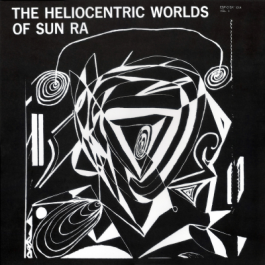 |
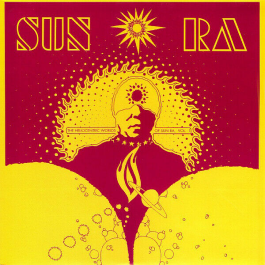 |
The two versions of the 1965 album The Heliocentric Worlds of Sun Ra (Volume 1) were part of the inspiration for Meisha Synnott’s enlightening artistic exploration
.
.
___
.
.
Listen to Sun Ra’s “Heliocentric”
.
.
.
___
.
.
Heliocentric Ra Ra
by Meisha Synnott
.
…..It’s hard to imagine moving through forty odd years of life, being interested in jazz music, and not encountering the name Sun Ra. I knew the name and also that there was a reasonable amount of ‘hype’ associated with it, but nothing more. One afternoon quite randomly I decided to see what all the ‘hype’ was about. I opened my streaming service and not knowing any of his albums randomly selected one; Heliocentric Worlds, Vol 1. And that is how I found myself listening for the first (knowing) time to Sun Ra.
…..An emotional resonance accumulated while listening to the music that afternoon and from that vibrational energy an impulse to create. I taped some large sheets of paper to the wall, chose a track from the album, and pressed “play.” After simply listening with my eyes closed for a period I began physically responding to the music; emotion from the music into the body onto the paper. It was blind improvisation. I did not look at the paper, the process was at the foreground and the rhythms developed into an expanding sense of free mark making. Time was stretched and a sensory exchange feedback loop existed between sound and form. At the end of the track it would play again, looping, until I felt the piece in the first instance was finished and I put down the pastels and looked. I did this same process over several discrete sessions to generate multiple first stage pieces. Later, stage two was more deliberate and considered occurring over several sittings for each piece. I made additions and alterations in order to create something I felt was realised.
.
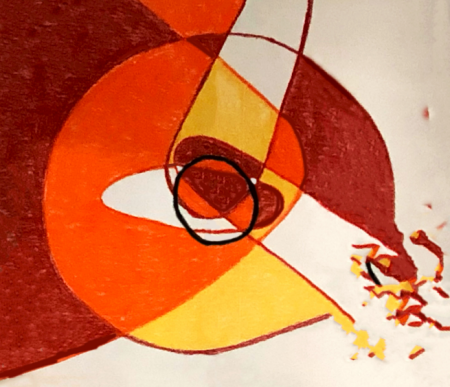
.
…..The tracks on this album pull at their melodies, pull at their beats. The elements break apart but remain unified; instruments weaving improvisations within an overall collectivity. They share a contour. I wanted my pieces to have a conscious rhythm and reflective rhyme but not ones that were unbreakable and without chaos. The works have a repetition and layering in the abstract mark making and an accumulation of circular motifs from which the other elements hang. The narratives have been left open. Ultimately I wanted the marks to show the piling of my emotional landscapes, landscapes from which both the image ground and the stroke grew.
.

.
…..I have seen the two album cover designs. The original black and white created by Sun Ra and the second red and orange version. I think once knowing something it is impossible to remove it completely from your mind and act at all levels independently of it. While my drawings, stage one and two, were inspired by the music there is no doubt a presence of these covers in my pieces.
.
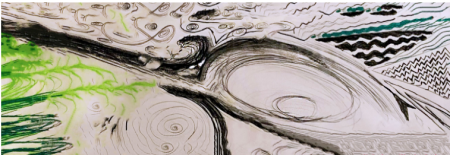
.
…..For me, jazz is emotional, spiritual and intellectual. It is a story. It tells and creates stories. Many stories. Jazz, like all music, can inspire us to, as Sun Ra said, “face the music” of all that has been and consider all that may be. To redraw boundaries and consider new dimensions; questioning one’s “alter-destiny” and “(my-)story” (Sun Ra). Sometimes an album or artist comes along that embodies the redefining of impossible and possible. And if not the actual begetter of such things they are irrefutable evidence of precedent. Heliocentric Worlds, Vol 1 is the music of space creation and represents a place used by Sun Ra “to talk to people” about “try(ing) the impossible.” Sun Ra himself reported an otherworldly experience during his college years, claiming he had been teleported to Saturn and that the bodies responsible for this teleportation had spoken to him. They tell Sun Ra he would speak to the world through music and the world would listen. The lasting consequences of this experience would shape his boundary breaking life.
…..It can be easy to forget the cultural placement of a thing once the characteristics of that thing have become a ubiquitary existence. Kazimir Malevich’s Suprematist Composition: White on White 1918 was a ground breaking radical painting. It had no reference to the external world; it broke from a tradition based on ever greater degrees of verisimilitude. Now the physical body of a painted white canvas has been seen by all and we have to get the to philosophy and intention to embrace its uniqueness. In 1965 the compositional elements of Heliocentric Worlds, Vol 1 represented the breaking into something new. Poetry, music, fine arts, any of the above and others. These words are semantic categories, versions of a same artistic lexicon; communication and expression. They are history, present, future, imagination, propaganda, mimesis, and story. There is no hierarchy of importance. Sound goes beyond hearing. Sight is is more than what is perceived by the eyes. It isn’t the medium that matters but how you approach the medium.
…..I’m going back to school later this year as a mature age student to study fine arts. Why fine arts and not English or music? I’m not sure; it felt the best fit from these versions of the same. I am excited and looking forward to it! I feel I am saying “yes” to myself for the first time in my adult life. I am not sure what success means to me and I am not sure what I want the outcome of school to look like, but I do know I want to give my art a world greater than my own. I also know music will play an important part of my practice. Music in all its forms; jazz, classical, rap, electronic, field recordings of birds in the morning or a door squeaking shut. We are surrounded by music, internally and externally. There is a latency if we stop and sensitively listen. Everything has a song.
.
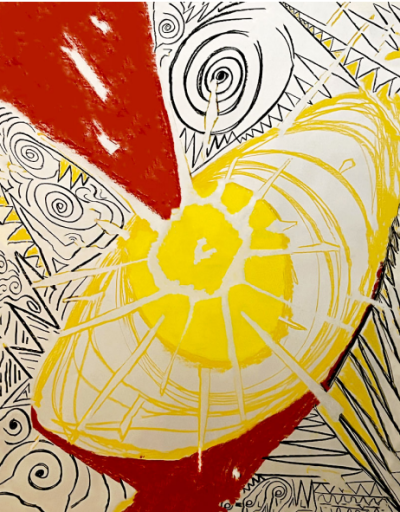
.
.
___
.
.
Listen to “Of Heavenly Things,” from Heliocentric Worlds of Sun Ra, Vol. 1
.
.
___
.
.

Meisha Synnott grew up in the Australian bush where she cared for injured wildlife. She continued this work as an adult being involved with organisations such as WIRES, a wildlife rescue and care organisation, and Land for Wildlife, a conservation initiative. In January 2022 she moved to Canada with her husband and their kelpie, an Australian breed of herding dog. She has studied classical piano and played saxophone in a small jazz group and will commence fine arts at AUArts in September 2022.
.
.
___
.
.
Click here to learn how to submit your work to Jerry Jazz Musician
Click here to learn how to subscribe to the Jerry Jazz Musician newsletter
.
.
.









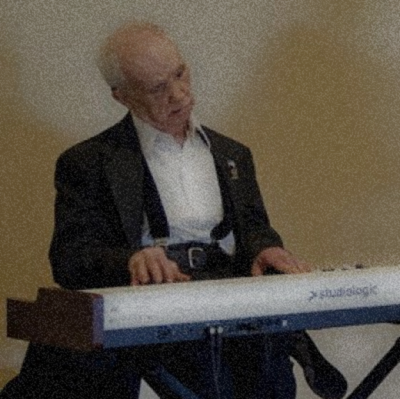






























Inspiring insightful article by a clever mind. A terrific read with artistic interpretation. Thx you Meisha.